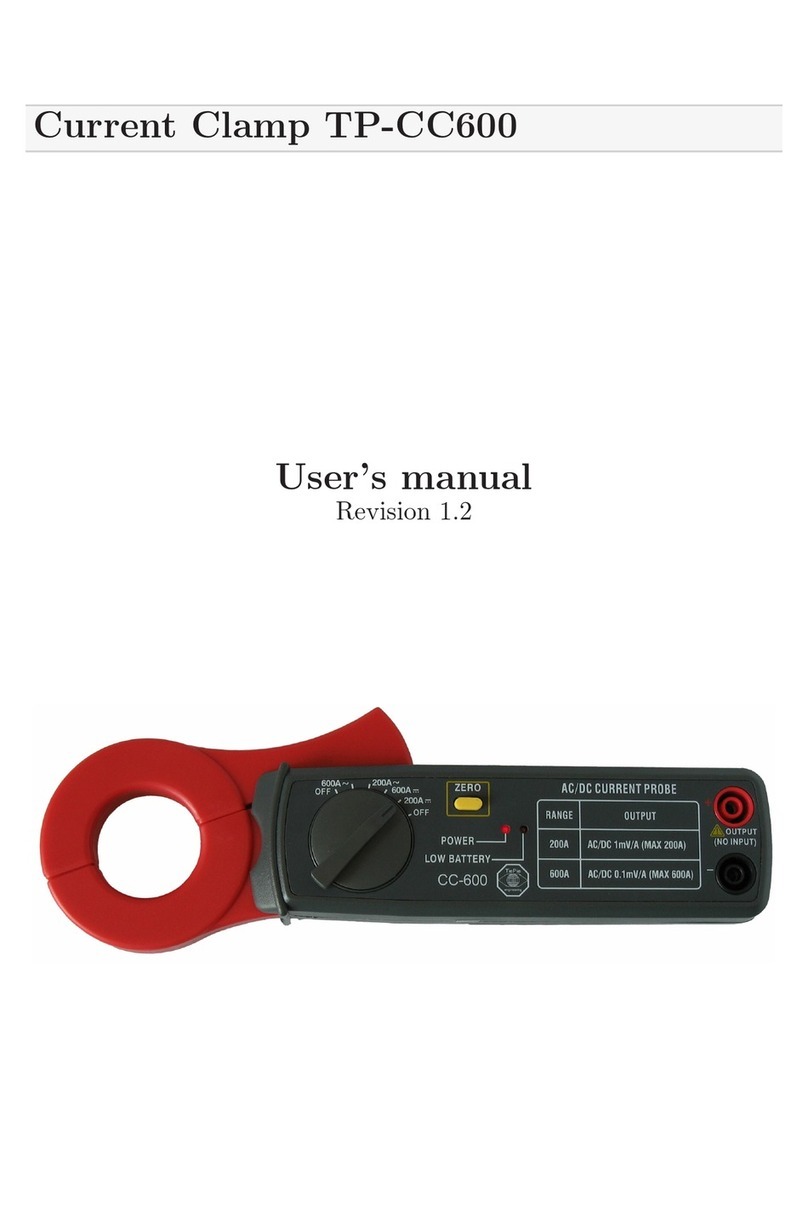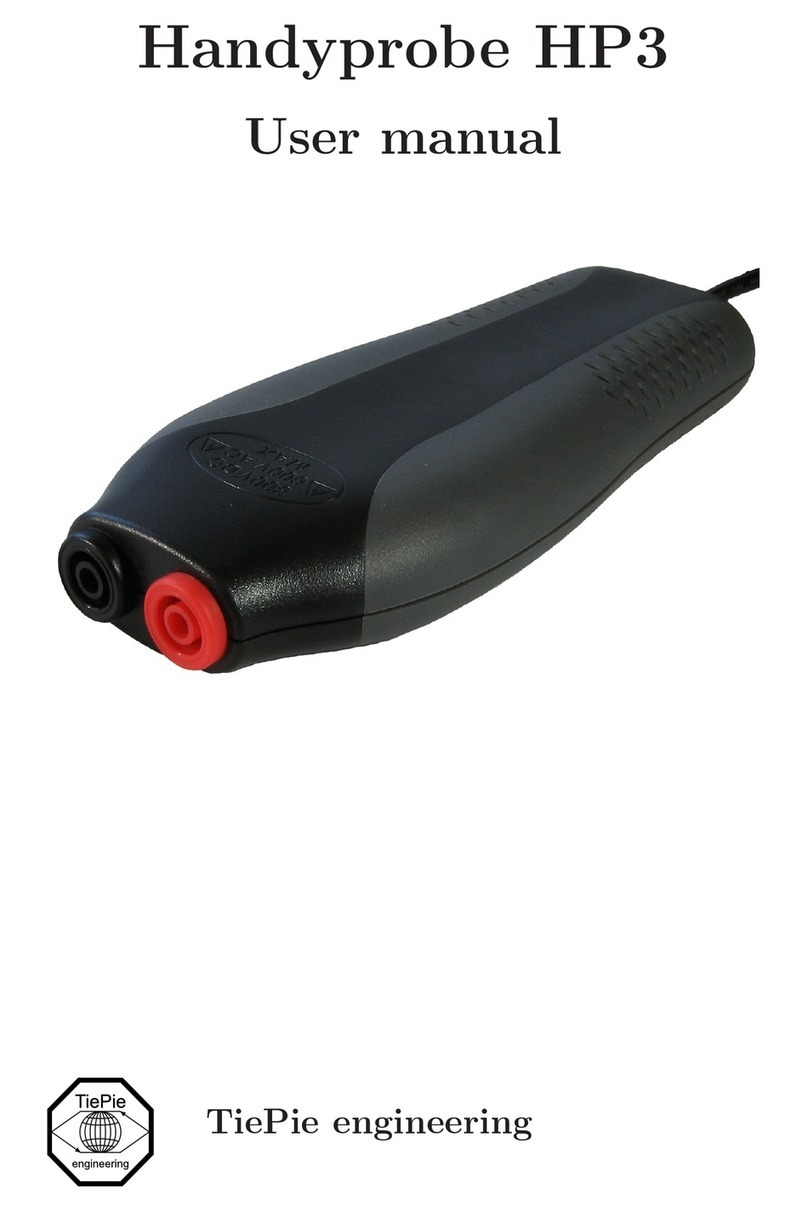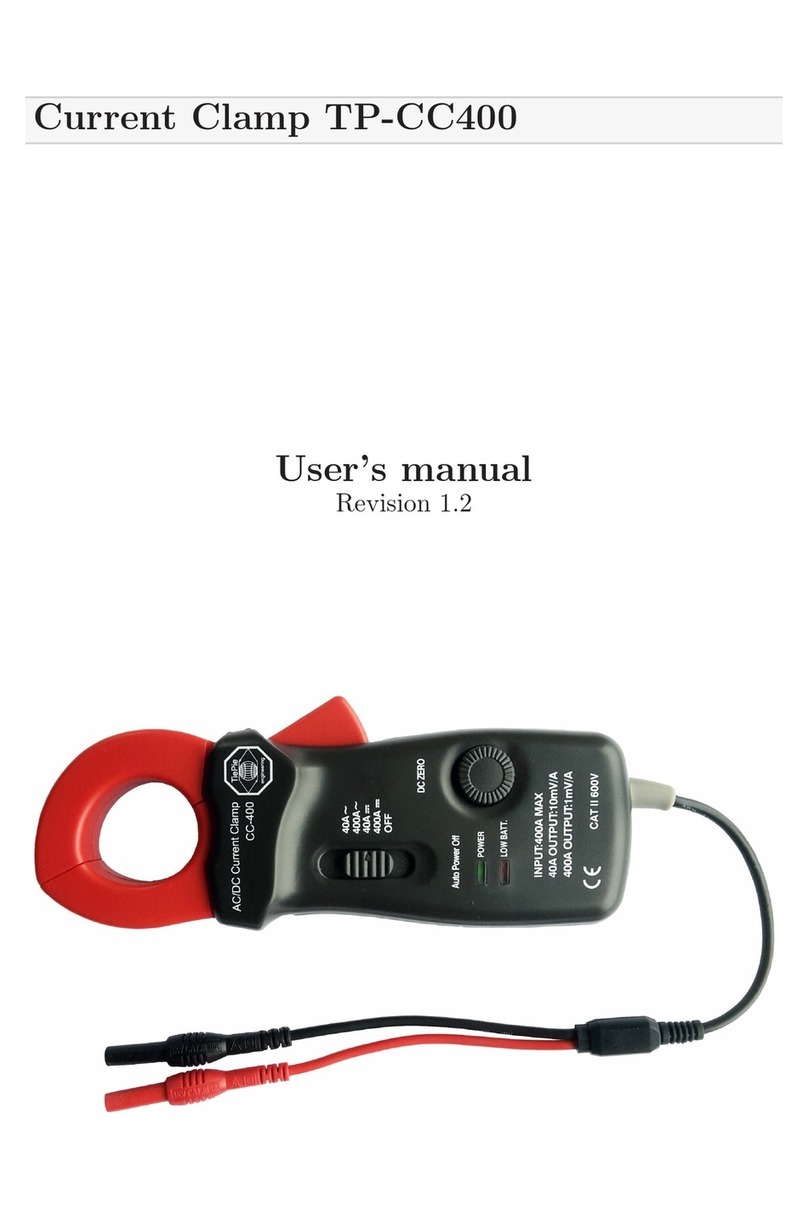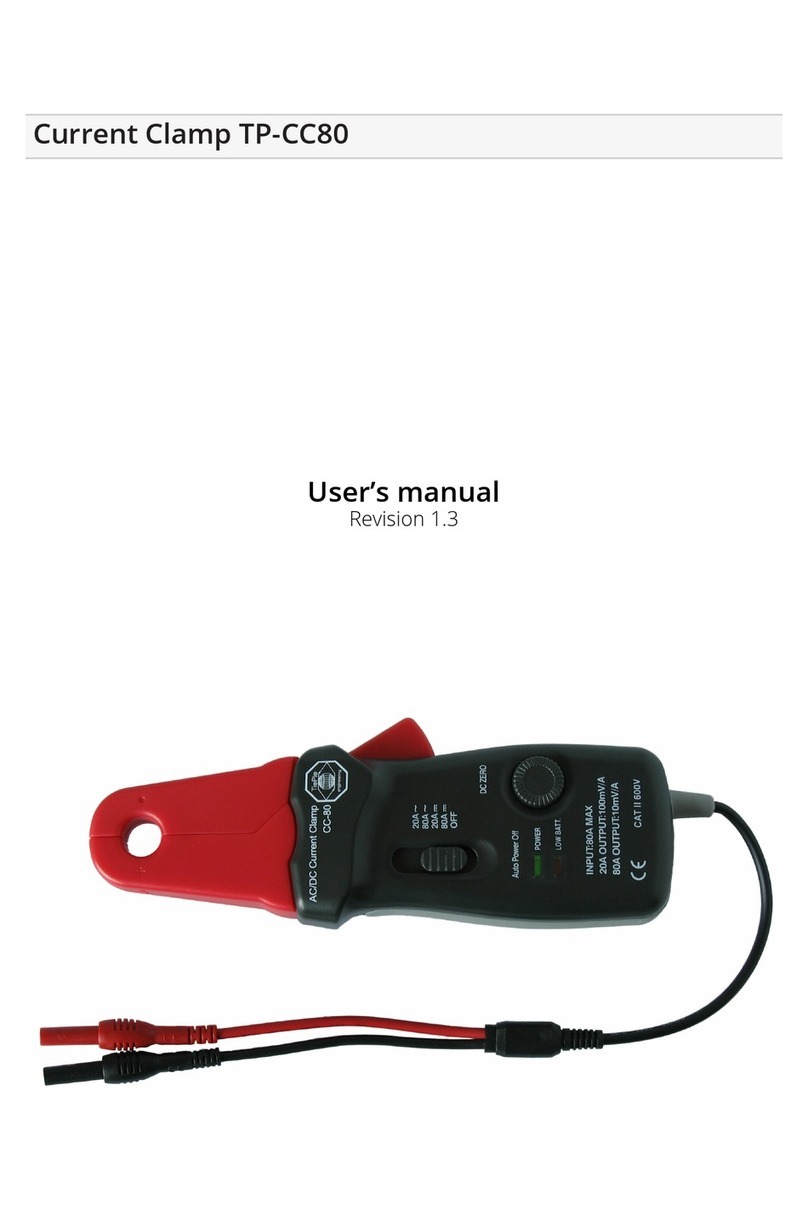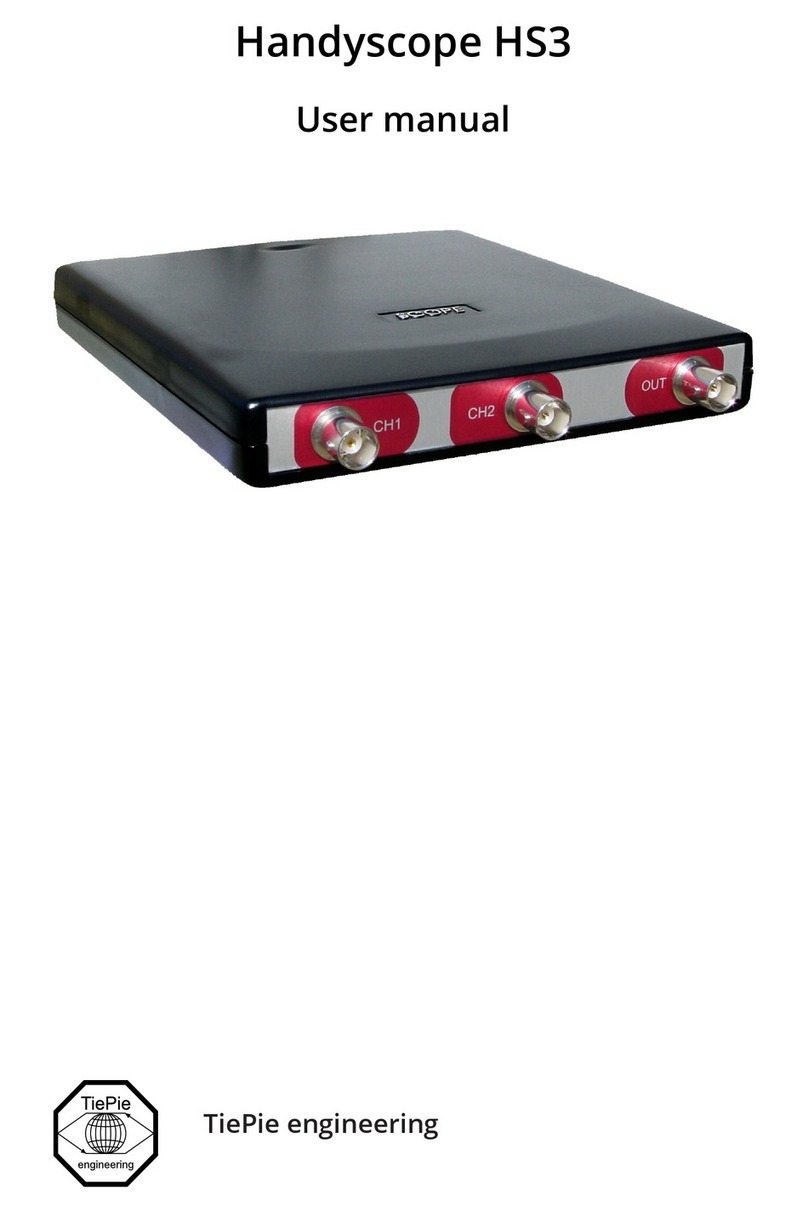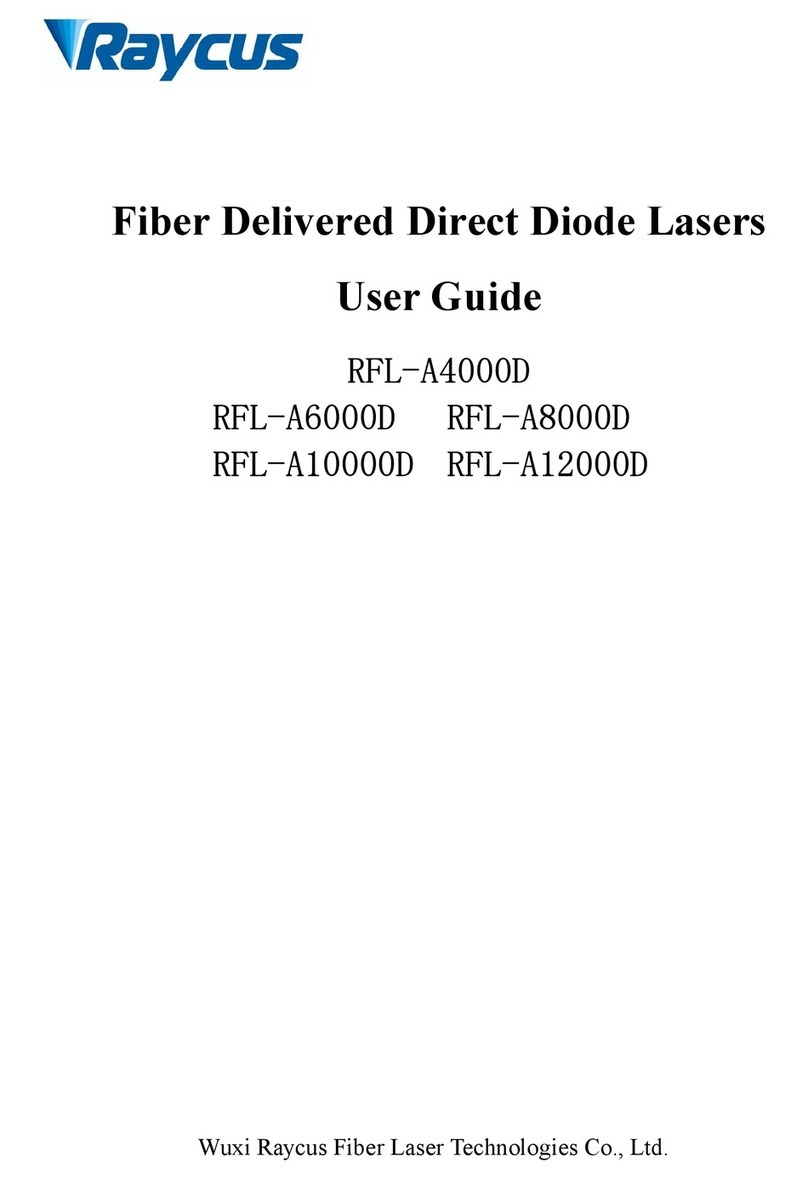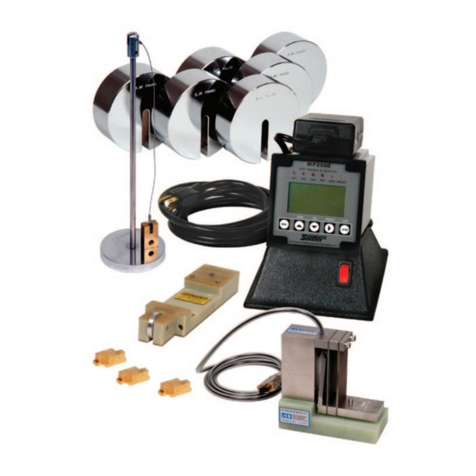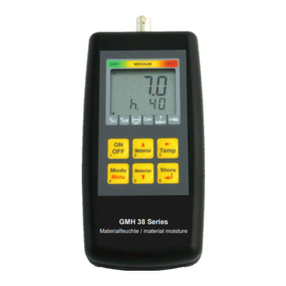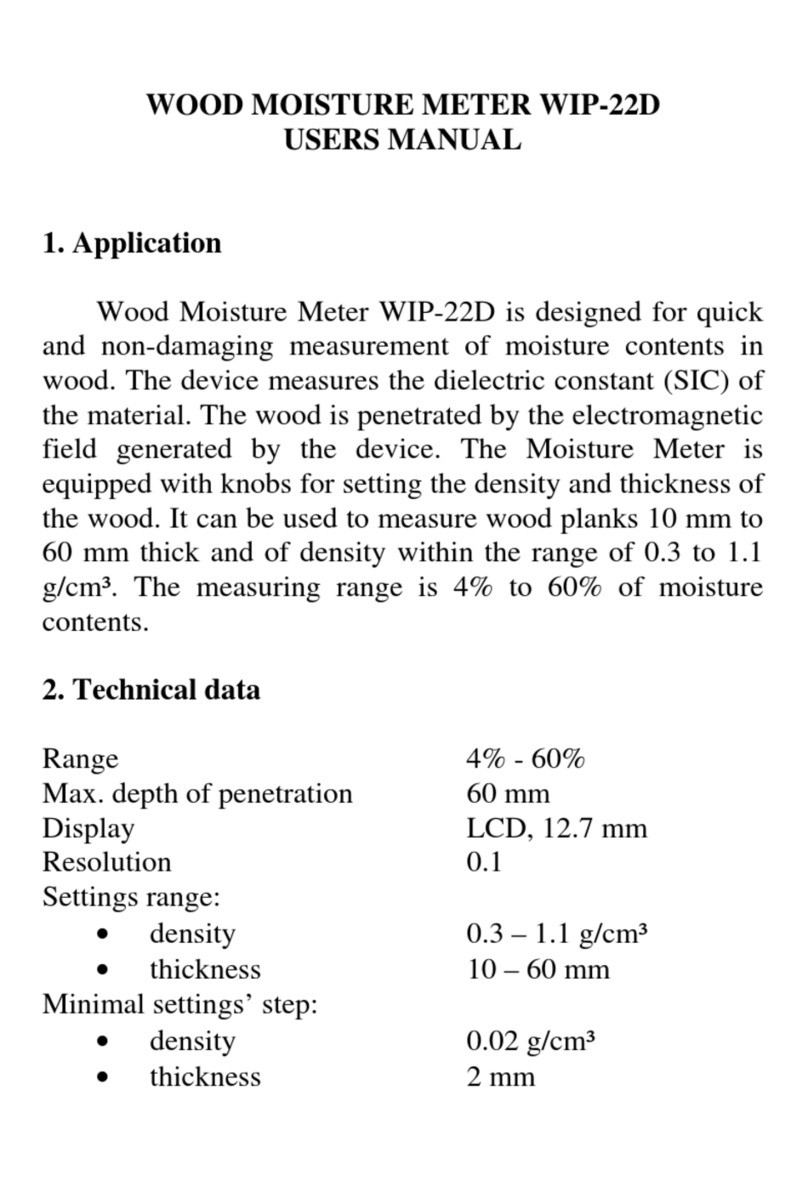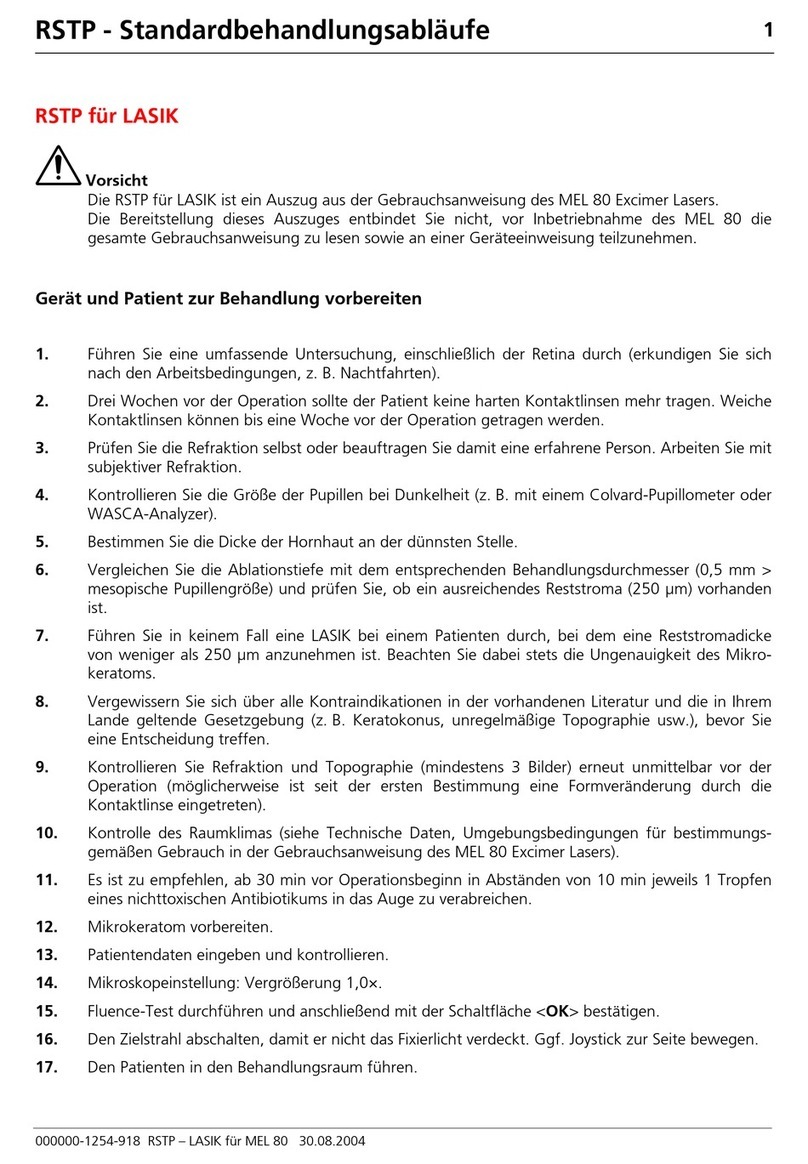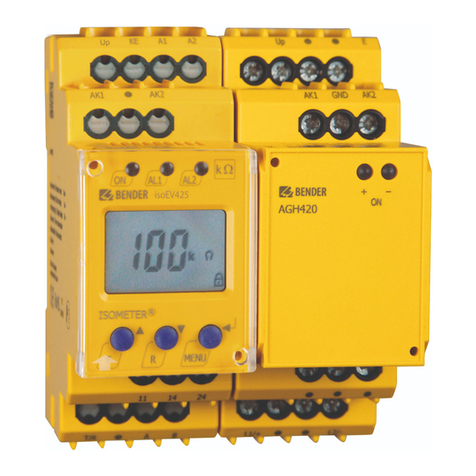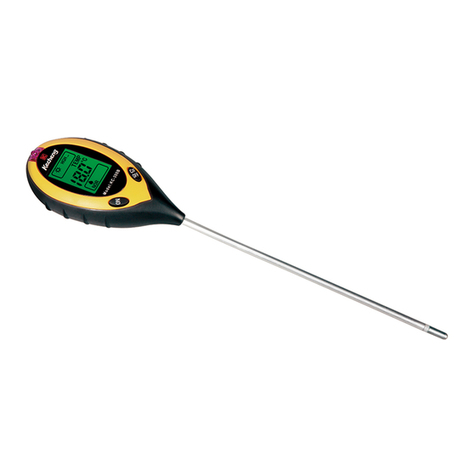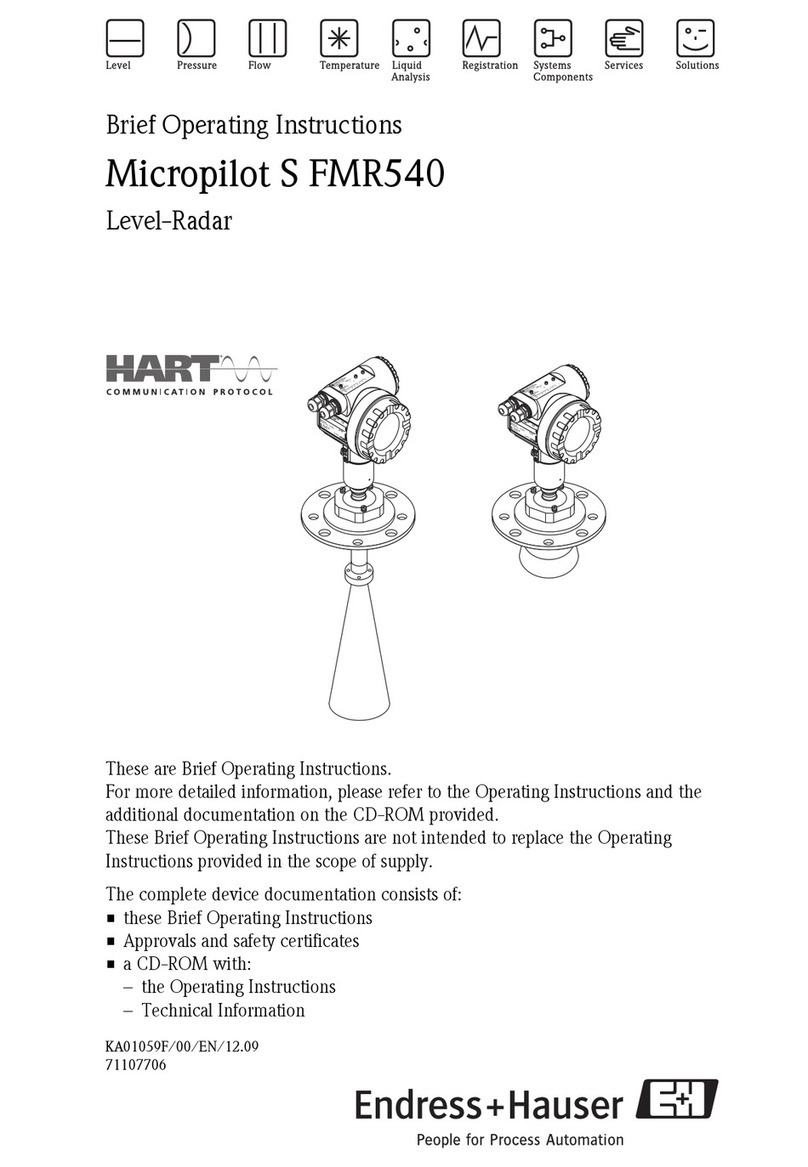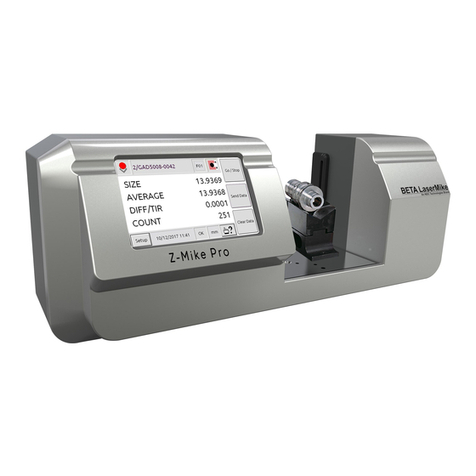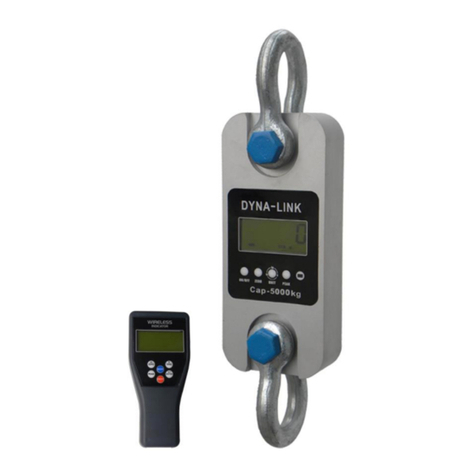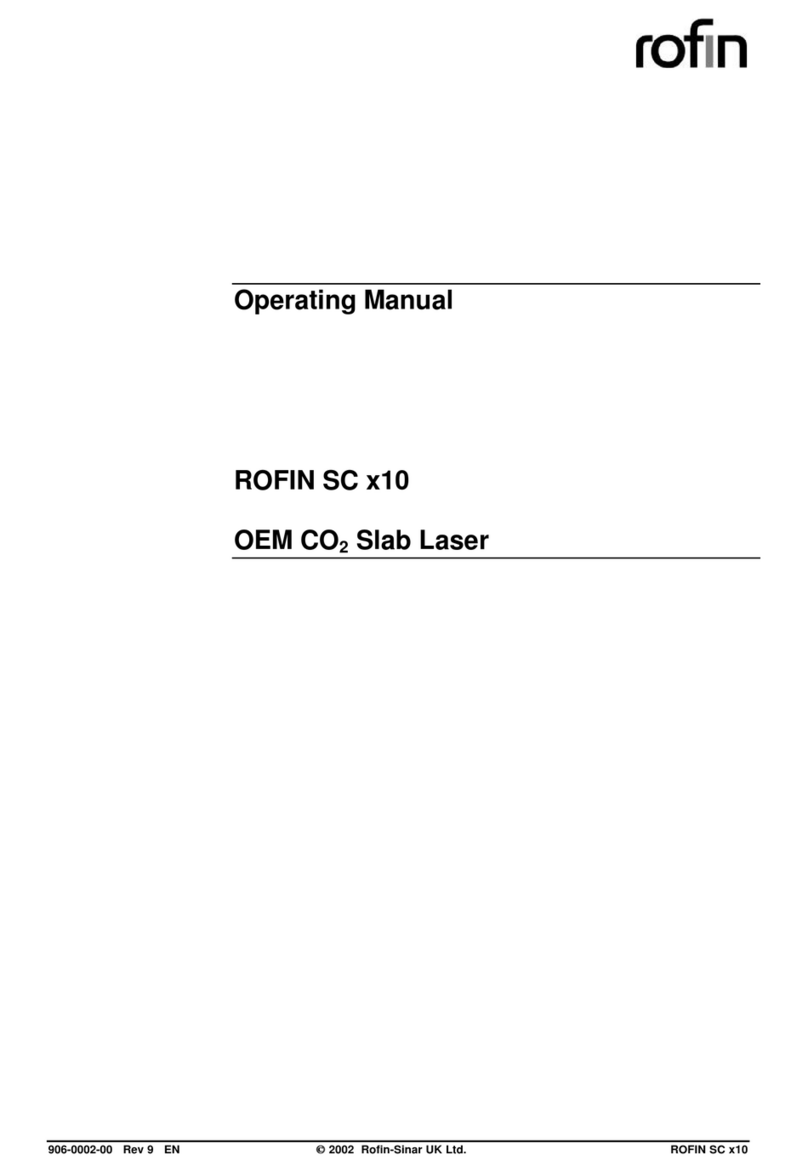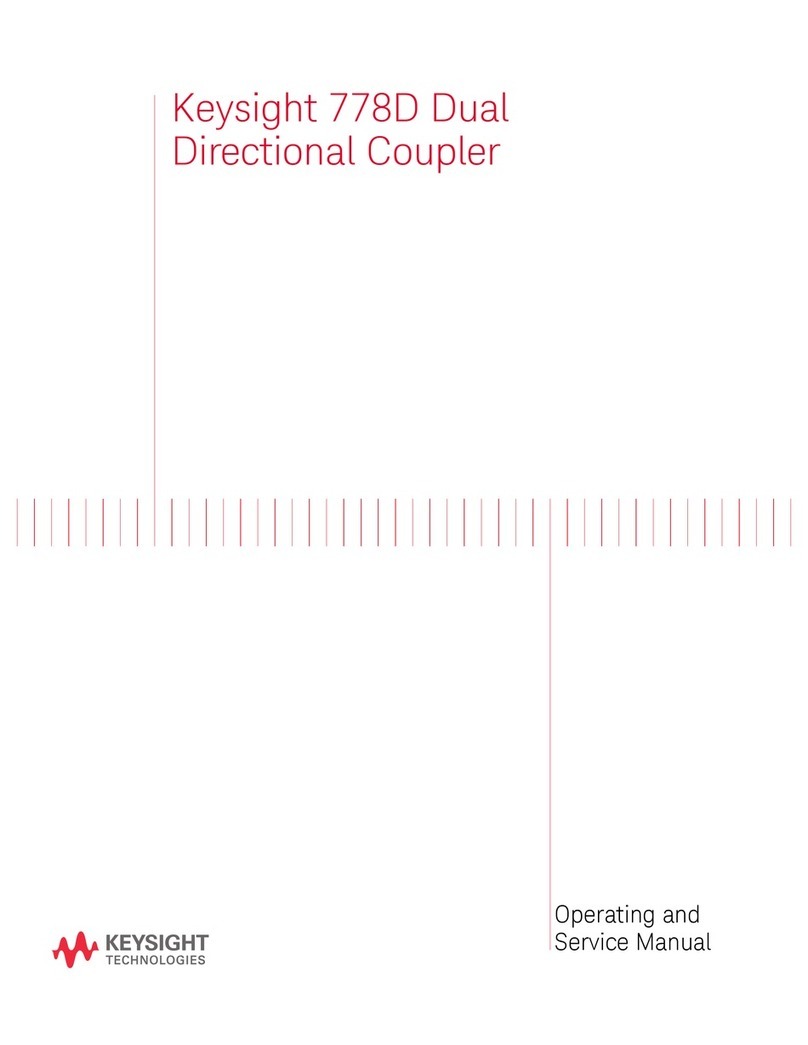TiePie Handyscope HS4 User manual

Handyscope HS4 DIFF
Instrument manual
Rev. 2.1
TiePie engineering

ATTENTION!
Measuring directly on the line voltage can be very dan-
gerous.
Despite the care taken for the compilation of this user manual, TiePie
engineering can not be held responsible for any damages resulting from
errors that may appear in this book.
Copyright c
2011 TiePie engineering. All rights reserved.

Contents
1 Safety 1
2 Declaration of confirmity 3
3 Introduction 5
3.1 Differential input .................... 5
3.1.1 Differential attenuators ............ 7
3.1.2 Differential test lead .............. 9
3.2 Sampling ........................ 9
3.3 Sample frequency .................... 10
3.3.1 Aliasing ..................... 11
3.4 Digitizing ........................ 13
3.5 Signal coupling ..................... 13
4 Driver installation 15
4.1 Introduction ....................... 15
4.2 Where to find the driver setup ............ 15
4.3 Executing the installation utility ........... 15
5 Hardware installation 21
5.1 Power the instrument ................. 21
5.1.1 External power ................. 21
5.2 Connect the instrument to the computer ....... 22
5.2.1 Found New Hardware Wizard ......... 23
5.3 Plug into a different USB port ............ 25
6 Front panel 27
6.1 Channel input connectors ............... 27
6.2 Power indicator ..................... 27
7 Rear panel 29
7.1 Power .......................... 29
7.1.1 USB power cable ................ 30
7.1.2 Power adapter ................. 31
7.2 USB ........................... 31
7.3 Extension Connector .................. 31
8 Specifications 33
Contents I

8.1 Acquisition system ................... 33
8.2 BNC inputs Ch1 – Ch4 ................ 33
8.3 Trigger system ..................... 34
8.4 Interface ......................... 34
8.5 Power .......................... 34
8.6 Physical ......................... 34
8.7 I/O connectors ..................... 35
8.8 System requirements .................. 35
8.9 Operating environment ................. 35
8.10 Storage environment .................. 35
8.11 Certifications and Compliances ............ 35
8.12 Package ......................... 35
II

Safety 1
When working with electricity, no instrument can guaran-
tee complete safety. It is the responsibility of the person
who works with the instrument to operate it in a save way.
Maximum security is achieved by selecting the proper in-
struments and following save working procedures. Save
working tips are given below:
•Always work according (local) regulations.
•Work on installations with voltages higher than 25 V AC or
60 V DC should only be performed by qualified personnel.
•Avoid working alone.
•Observe all indications on the Handyscope HS4 DIFF before
connecting any wiring
•Check the probes/test leads for damages. Do not use them
if they are damaged
•Take care when measuring at voltages higher than 25V AC
or 60 V DC.
•Do not operate the equipment in an explosive atmosphere or
in the presence of flammable gases or fumes.
•Do not use the equipment if it does not operate properly.
Have the equipment inspected by qualified service personal.
If necessary, return the equipment to TiePie engineering for
service and repair to ensure that safety features are main-
tained.
Safety 1

2Chapter 1

Declaration of confirmity 2
TiePie engineering
Koperslagersstraat 37
8601 WL Sneek
The Netherlands
EC Declaration of confirmity
We declare, on our own responsibility, that the product
Handyscope HS4 DIFF-5MHz
Handyscope HS4 DIFF-10MHz
Handyscope HS4 DIFF-25MHz
Handyscope HS4 DIFF-50MHz
for which this declaration is valid, is in compliance with
EN 55011:2009/A1:2010 EN 61000-6-1:2007
EN 55022:2006/A1:2007 EN 61000-6-3:2007
according the conditions of the EMC standard 2004/108/EC.
Sneek, 1-11-2010
ir. A.P.W.M. Poelsma
Declaration of confirmity 3

4Chapter 2

Introduction 3
Before using the Handyscope HS4 DIFF first read chapter 1
about safety.
Many technicians investigate electrical signals. Though the mea-
surement may not be electrical, the physical variable is often con-
verted to an electrical signal, with a special transducer. Common
transducers are accelerometers, pressure probes, current clamps
and temperature probes. The advantages of converting the physical
parameters to electrical signals are large, since many instruments
for examining electrical signals are available.
The Handyscope HS4 DIFF is a portable four channel measuring
instrument with differential inputs. The Handyscope HS4 DIFF
is available in several models with different maximum sampling
frequencies: 5 MS/s, 10 MS/s, 25 MS/s or 50 MS/s. The native
resolution is 12 bits, but user selectable resolutions of 14 and 16
bits are available too, with adjusted maximum sampling frequency:
resolution Maximum sampling frequency
12 bit 5, 10, 25 or 50 MS/s, depending on model
14 bit 3.125 MS/s
16 bit 195 kS/s
Table 3.1: Maximum sampling frequencies
With the accompanying software the Handyscope HS4 DIFF can be
used as an oscilloscope, a spectrum analyzer, a true RMS voltmeter
or a transient recorder. All instruments measure by sampling the
input signals, digitizing the values, process them, save them and
display them.
3.1 Differential input
Most oscilloscopes are equipped with standard, single ended inputs,
which are referenced to ground. This means that one side of the
Introduction 5

input is always connected to ground and the other side to the point
of interest in the circuit under test.
Figure 3.1: Single ended input
Therefore the voltage that is measured with an oscilloscope with
standard, single ended inputs is always measured between that
specific point and ground.
When the voltage is not referenced to ground, connecting a stan-
dard single ended oscilloscope input to the two points would create
a short circuit between one of the points and ground, possibly dam-
aging the circuit and the oscilloscope.
A safe way would be to measure the voltage at one of the two
points, in reference to ground and at the other point, in reference
to ground and then calculate the voltage difference between the
two points. On most oscilloscopes this can be done by connecting
one of the channels to one point and another channel to the other
point and then use the math function Ch1 - Ch2 in the oscilloscope
to display the actual voltage difference.
There are some disadvantages to this method:
•a short circuit to ground can be created when an input is
wrongly connected
•to measure one signal, two channels are occupied
•by using two channels, the measurement error is increased,
the errors made on each channel will be combined, resulting
in a larger total measurement error
•The Common Mode Rejection Ratio (CMRR) of this method
is relatively low. If both points have a relative high voltage,
but the voltage difference between the two points is small,
the voltage difference can only be measured in a high input
range, resulting in a low resolution
A much better way is to use an oscilloscope with a differential
input.
6Chapter 3

Figure 3.2: Differential input
A differential input is not referenced to ground, but both sides of
the input are ”floating”. It is therefore possible to connect one
side of the input to one point in the circuit and the other side of
the input to the other point in the circuit and measure the voltage
difference directly.
Advantages of a differential input:
•No risk of creating a short circuit to ground
•Only one channel is required to measure the signal
•More accurate measurements, since only one channel intro-
duces a measurement error
•The CMRR of a differential input is high. If both points have
a relative high voltage, but the voltage difference between the
two points is small, the voltage difference can be measured
in a low input range, resulting in a high resolution
3.1.1 Differential attenuators
To increase the input range of the Handyscope HS4 DIFF, it comes
with a differential 1:10 attenuator for each channel. This differen-
tial attenuator is specially designed to be used with the Handyscope
HS4 DIFF.
Figure 3.3: Differential attenuator
For a differential input, both sides of the input need to be attenu-
ated.
Introduction 7

Figure 3.4: Differential input
Standard oscilloscope probes and attenuators only attenuate one
side of the signal path. These are not suitable to be used with
a differential input. Using these on a differential input will have
a negative effect on the CMRR and will introduce measurement
errors.
Figure 3.5: Differential input
The Differential Attenuator and the inputs of the Handy-
scope HS4 Diff are differential, which means that the outside
of the BNC’s are not grounded, but carry life signals.
When using the attenuator, the following points have to be taken
into consideration:
•do not connect other cables to the attenuator than the ones
that are supplied with the instrument
•do not touch the metal parts of the BNC’s when the atten-
uator is connected to the circuit under test, they can carry
8Chapter 3

a dangerous voltage. It will also influence the measurements
and create measurement errors.
•do not connect the outside of the two BNC’s of the attenuator
to each other as this will short circuit a part of the internal
circuit and will create measurement errors
•do not connect the outside of the BNC’s of two or more at-
tenuators that are connected to different channels of the Han-
dyscope HS4 Diff to each other
•do not apply excessive mechanical force to the attenuator in
any direction (e.g. pulling the cable, using the attenuator as
handle to carry the Handyscope HS4 DIFF, etc.)
3.1.2 Differential test lead
The Handyscope HS4 DIFF comes with a special differential test
lead. This test lead is specially designed to ensure a good CMRR.
The special heat resistant differential test lead provided with the
Handyscope HS4 DIFF is designed to be immune for noise from
the surrounding environment.
3.2 Sampling
When sampling the input signal, samples are taken at fixed inter-
vals. At these intervals, the size of the input signal is converted to a
number. The accuracy of this number depends on the resolution of
the instrument. The higher the resolution, the smaller the voltage
steps in which the input range of the instrument is divided. The
acquired numbers can be used for various purposes, e.g. to create
a graph.
Introduction 9

Figure 3.6: Sampling
The sine wave in figure 3.6 is sampled at the dot positions. By
connecting the adjacent samples, the original signal can be recon-
structed from the samples. You can see the result in figure 3.7.
Figure 3.7: ”connecting” the samples
3.3 Sample frequency
The rate at which the samples are taken is called the sampling
frequency, the number of samples per second. A higher sampling
frequency corresponds to a shorter interval between the samples.
As is visible in figure 3.8, with a higher sampling frequency, the
original signal can be reconstructed much better from the measured
samples.
10 Chapter 3

Figure 3.8: The effect of the sampling frequency
The sampling frequency must be higher than 2 times the highest
frequency in the input signal. This is called the Nyquist fre-
quency. Theoretically it is possible to reconstruct the input signal
with more than 2 samples per period. In practice, 10 to 20 sam-
ples per period are recommended to be able to examine the signal
thoroughly.
3.3.1 Aliasing
When sampling an analog signal with a certain sampling frequency,
signals appear in the output with frequencies equal to the sum and
difference of the signal frequency and multiples of the sampling
frequency. For example, when the sampling frequency is 1000 Hz
and the signal frequency is 1250 Hz, the following signal frequencies
will be present in the output data:
Multiple of sampling frequency 1250 Hz signal -1250 Hz signal
...
-1000 -1000 + 1250 = 250 -1000 - 1250 = -2250
0 0 + 1250 = 1250 0 - 1250 = -1250
1000 1000 + 1250 = 2250 1000 - 1250 = -250
2000 2000 + 1250 = 3250 2000 - 1250 = 750
...
Table 3.2: Aliasing
As stated before, when sampling a signal, only frequencies lower
than half the sampling frequency can be reconstructed. In this
case the sampling frequency is 1000 Hz, so we can we only observe
Introduction 11

signals with a frequency ranging from 0 to 500 Hz. This means
that from the resulting frequencies in the table, we can only see
the 250 Hz signal in the sampled data. This signal is called an
alias of the original signal.
If the sampling frequency is lower than twice the frequency of the
input signal, aliasing will occur. The following illustration shows
what happens.
Figure 3.9: Aliasing
In figure 3.9, the green input signal (top) is a triangular signal with
a frequency of 1.25 kHz. The signal is sampled with a frequency of
1 kHz. The corresponding sampling interval is 1/1000Hz = 1ms.
The positions at which the signal is sampled are depicted with
the blue dots. The red dotted signal (bottom) is the result of the
reconstruction. The period time of this triangular signal appears
to be 4 ms, which corresponds to an apparent frequency (alias) of
250 Hz (1.25 kHz - 1 kHz).
To avoid aliasing, always start measuring at the highest sam-
pling frequency and lower the sampling frequency if required.
12 Chapter 3

3.4 Digitizing
When digitizing the samples, the voltage at each sample time is
converted to a number. This is done by comparing the voltage
with a number of levels. The resulting number is the number cor-
responding to the level that is closest to the voltage. The number
of levels is determined by the resolution, according to the following
relation: LevelCount = 2Resolution .
The higher the resolution, the more levels are available and the
more accurate the input signal can be reconstructed. In figure 3.10,
the same signal is digitized, using two different amounts of levels:
16 (4-bit) and 64 (6-bit).
Figure 3.10: The effect of the resolution
The Handyscope HS4 DIFF measures at e.g. 12 bit resolution
(212=4096 levels). The smallest detectable voltage step depends
on the input range. This voltage can be calculated as:
V oltageStep =F ullInputRange/LevelCount
For example, the 200 mV range ranges from -200 mV to +200
mV, therefore the full range is 400 mV. This results in a smallest
detectable voltage step of 0.400V/4096 = 97.65 µV.
3.5 Signal coupling
The Handyscope HS4 DIFF has two different settings for the signal
coupling: AC and DC. In the setting DC, the signal is directly
Introduction 13

coupled to the input circuit. All signal components available in the
input signal will arrive at the input circuit and will be measured.
In the setting AC, a capacitor will be placed between the input
connector and the input circuit. This capacitor will block all DC
components of the input signal and let all AC components pass
through. This can be used to remove a large DC component of the
input signal, to be able to measure a small AC component at high
resolution.
When measuring DC signals, make sure to set the signal
coupling of the input to DC.
14 Chapter 3

Driver installation 4
Before connecting the Handyscope HS4 DIFF to the com-
puter, the drivers need to be installed.
4.1 Introduction
To operate a Handyscope HS4 DIFF, a driver is required to inter-
face between the measurement software and the instrument. This
driver takes care of the low level communication between the com-
puter and the instrument, through USB. When the driver is not
installed, or an old, no longer compatible version of the driver is
installed, the software will not be able to operate the Handyscope
HS4 DIFF properly or even detect it at all.
The installation of the USB driver is done in a few steps. Firstly,
the driver has to be pre-installed by the driver setup program. This
makes sure that all required files are located where Windows can
find them. When the instrument is plugged in, Windows will detect
new hardware and install the required drivers.
4.2 Where to find the driver setup
The driver setup program and measurement software can be found
in the download section on TiePie engineering’s website and on the
CD-ROM that came with the instrument. It is recommended to
install the latest version of the software and USB driver from the
website. This will guarantee the latest features are included.
4.3 Executing the installation utility
To start the driver installation, execute the downloaded driver
setup program, or the one on the CD-ROM that came with the
instrument. The driver install utility can be used for a first time
Driver installation 15

installation of a driver on a system and also to update an existing
driver.
The screen shots in this description may differ from the ones dis-
played on your computer, depending on the Windows version.
Figure 4.1: Driver install: step 1
When drivers were already installed, the install utility will remove
them before installing the new driver. To remove the old driver
successfully, it is essential that the Handyscope HS4 DIFF is
disconnected from the computer prior to starting the driver install
utility. When the Handyscope HS4 DIFF is used with an external
power supply, this must be disconnected too.
16 Chapter 4
Other manuals for Handyscope HS4
2
This manual suits for next models
2
Table of contents
Other TiePie Measuring Instrument manuals
